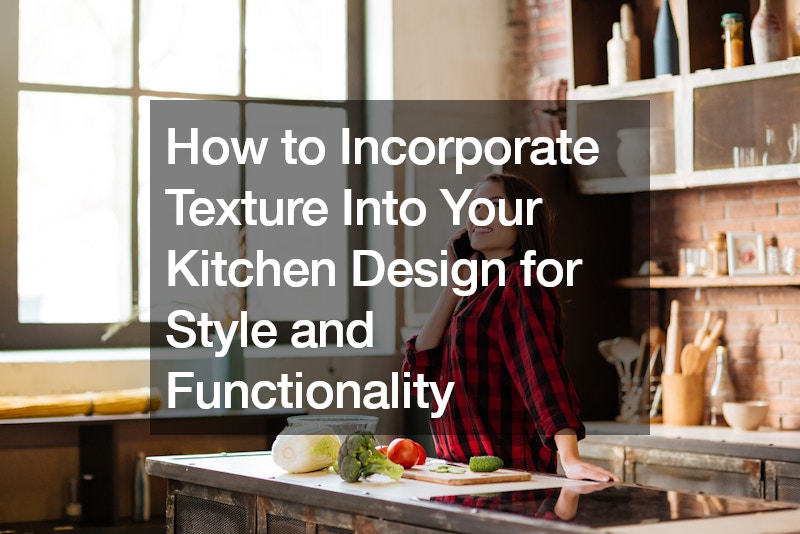
When it comes to designing a kitchen, texture is often an overlooked yet powerful element that can significantly enhance the overall aesthetic and feel of the space. By incorporating various textures strategically, you not only add visual interest but also create a more dynamic and inviting environment. Whether you’re aiming for a cozy farmhouse kitchen or a sleek modern space, here are some effective ways to infuse texture into your kitchen design.
1. Textured Cabinets
Start by considering textured cabinets, as they can dramatically transform the look and feel of your kitchen. Opt for cabinet doors with details like reeded, fluted, or slatted patterns.
These textures not only add visual interest but also break the monotony of smooth surfaces, creating a sense of depth and sophistication. Additionally, using textured cabinet doors on a kitchen island or specific sections can create a striking contrast with flat surfaces elsewhere in the kitchen.
2. Textured Walls
Adding texture to your kitchen walls is another effective way to introduce depth and character. Consider using finishes like lime wash or textured plaster. Lime wash, in particular, offers a matte, subtly textured appearance that brings a natural and earthy feel to the kitchen. The variations in color and texture that lime wash provides can create a bespoke charm, making your kitchen walls more than just a backdrop but a standout feature of the space.
3. Textured Countertops
Your choice of countertops can significantly impact the texture and overall aesthetic of your kitchen. From matte finishes to more pronounced textures like rivered or volcanic surfaces, there are various options to explore. Matte and honed finishes provide a smooth yet non-glossy surface that adds a contemporary touch to your kitchen. On the other hand, rivered textures mimic natural erosion patterns, offering a more organic and dynamic element. Volcanic textures bring a robust and earthy character to the space, though they may require more maintenance due to their pronounced texture.
4. Wood Veneer Doors
For those who appreciate the warmth of natural materials, wood veneer doors are an excellent choice. They showcase the beautiful grain details of wood, ranging from subtle and elegant to bold and rustic. Rough-sawn wood veneers, in particular, evoke a sense of raw craftsmanship and can complement various kitchen styles, from industrial to farmhouse. Running your hand over a wood veneer door allows you to appreciate the texture of the grain, adding a tactile dimension to your kitchen design.
5. Flooring Choices
The flooring in your kitchen not only serves a functional purpose but also plays a crucial role in setting the tone of the space. Wooden floors, whether solid wood or engineered, add warmth and a classic appeal. Engineered wood, with its enhanced durability and moisture resistance, is particularly suitable for kitchen environments. Natural stone tiles, on the other hand, offer a luxurious and varied look, with each tile unique in pattern, color, and texture. If you’re unsure about installation, a professional tile installation service can ensure your flooring is installed correctly and efficiently. When choosing flooring, you should also factor in maintenance requirements and how it aligns with your kitchen’s style and lifestyle needs.
6. Mixed Material Countertops
Embrace the trend of mixed material countertops to add texture and visual interest to your kitchen. Combining warm wood sections with durable stone countertops like granite or quartz creates a balanced and striking aesthetic. The wood adds warmth and a natural touch, perfect for breakfast bars or dining areas, while the stone offers functionality and a sleek look for cooking zones. Similarly, pairing marble with metal accents such as copper or stainless steel creates a luxurious yet functional countertop that serves as a focal point in your kitchen.
7. Backsplash Textures
A textured backsplash can be a unique way to inject personality and style into your kitchen. Consider options like exposed brick for a rustic or industrial look, or Moroccan-inspired tiles with glossy finishes and slight imperfections for a handcrafted appeal. Beveled edge subway tiles add subtle texture and create dynamic shadow play on the walls, enhancing the overall visual interest of your kitchen.
8. Open Shelving and Decorative Accents
Open shelving not only provides practical storage but also offers an opportunity to showcase textured decorative items. Wooden open shelves, for instance, bring a warm and organic feel to the kitchen while serving as a stage for textured pottery, glass jars, woven baskets, and indoor plants. These elements add layers of texture and personality, transforming your kitchen into a more lived-in and inviting space.
Closing Thoughts
Incorporating texture into your kitchen design is a great way to upgrade its style and functionality. Whether through textured cabinets, walls, countertops, or flooring, each element contributes to creating a visually appealing and inviting kitchen environment. By carefully choosing and combining textures that complement your style preferences and lifestyle needs, you can turn your kitchen into a space that not only looks beautiful but also feels comfortable and welcoming. Experiment with these ideas to discover how texture can enhance the overall ambiance of your kitchen, making it a place where you love to cook, gather, and entertain.
.






